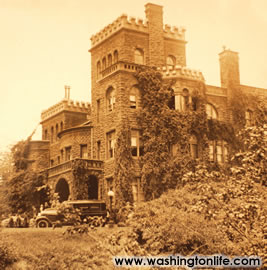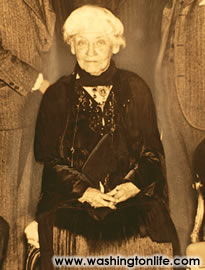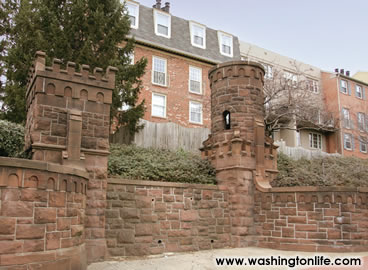|
Of Castles and Condos Mary Foote Henderson's "castle" may be gone, but her legacy remains BY DONNA EVERS
Mary Foote Henderson was a woman who had more than her share of vision and ambition. She was a suffragette and a teetotaler who married John Brooks Henderson, a Missouri senator best remembered as the drafter of the 13th Amendment abolishing slavery. Henderson became fabulously rich when the so-called "worthless" Civil War bonds he bought were redeemed by the government, so he and Mary moved to Washington, where Mary's ambitions were able to flourish. Mrs. Henderson bought a huge parcel of real estate in a sleepy rural area along what is now Florida Avenue, then named Boundary Street because it marked the edge of the city. She continued to buy up land around her, and then began one project after another to make her new neighborhood the center of power and prestige in Washington. She didn't do so badly; although, in the end, her dreams of glory were largely rejected, one after another. She built a brownstone castle as her own home, then engaged her architect friend, George Oakley Totten Jr., to build a handful of magnificent homes which she rented to embassies. This was her attempt to establish the neighborhood as the new "Embassy Row." She tried to have 16th Street renamed, "Avenue of the Presidents," an idea that collapsed soon after its suggestion. Undaunted, she attempted to have the White House moved to 16th Street. Obviously, this also failed. Striking again, she suggested a prime spot for the Lincoln Memorial to be located ... in her neighborhood, of course. When Congress rejected this plan, Mary Henderson made a last ditch effort by offering to gift one of her ambassadorial mansions to the federal government to be used as the vice president's residence. The federal government refused, thinking the mansion was too grand for a vice president. However, Mary Foote Henderson can be thanked for one success. In James Goode's book, Capitol Losses, the author tells how Mrs. Henderson became interested in the tract of land across 16th Street from her home, known as Meridian Hill. This location had inspired others besides Mary Henderson. In the beginning, it had been a Native American sacred place. Thomas Jefferson had once planned to mark the prime meridian for the globe (hence the name) from this commanding hilltop. At Mary's urging, Congress voted to purchase the 50 acre tract across from Henderson's Castle in 1910 for $460,000 and transform it into Meridian Hill Park, still one of the most beautiful parks in the city. Another success was a book, Practical Cooking and Dinner Giving, Mrs. Henderson wrote about entertaining, which was said to be the historic reference used for the dinner parties in the film of Edith Wharton's novel, The Age of Innocence. A dark moment for wine-lovers must also be noted here. When her husband died in 1913, Mary Henderson inherited not only his huge fortune, but also his illustrious wine cellar, which had been forty years in the making. When Prohibition came, she held a huge party where, it was reported in the Evening Star, she and her prohibitionist friends emptied the fabulous wine collection into the gutters and sewers of 16th Street. All Henderson parties thereafter were "dry." After Mary Foote Henderson died in 1931, her castle became a rooming house. Her neighbors, Eugene and Agnes Meyer, former owners of the Washington Post, got tired of the noise it generated and bought it. It was a school for a while before it was finally torn down in 1949. In 1976, builder Larry Brandt built the Beekman Place Condominiums on the site. The remnants of the castle walls are a reminder of that great golden age in Washington - from the 1880's to the 1920's - when so much of the city was shaped by the wealthy, ambitious people who came to town to lobby the federal government for influence and power. It is ironic that the remains of the castle surround condominium apartments, since Mary Henderson fought so hard to ensure that nothing as ordinary as apartment buildings would ever be built facing her beloved avenue.
|
||||||||||||||



